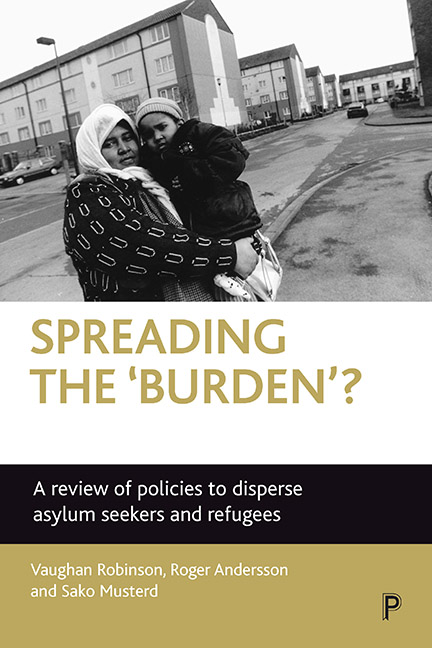Book contents
- Frontmatter
- Contents
- List of tables and figures
- Acknowledgements
- Glossary
- one Introduction
- two Defining the ‘problem’
- three Dispersal policies in the Netherlands
- four Dispersal policies in Sweden
- five Dispersal policies in the UK
- six What works? Improving the efficiency and effectiveness of dispersal
- seven Redefining the ‘problem’ and challenging the assumptions
- References
- Index
- Also available from The Policy Press
seven - Redefining the ‘problem’ and challenging the assumptions
Published online by Cambridge University Press: 20 January 2022
- Frontmatter
- Contents
- List of tables and figures
- Acknowledgements
- Glossary
- one Introduction
- two Defining the ‘problem’
- three Dispersal policies in the Netherlands
- four Dispersal policies in Sweden
- five Dispersal policies in the UK
- six What works? Improving the efficiency and effectiveness of dispersal
- seven Redefining the ‘problem’ and challenging the assumptions
- References
- Index
- Also available from The Policy Press
Summary
Introduction
Dispersal policies have been introduced in Western Europe because, when asylum seekers and refugees have been allowed to choose where they wish to settle within national space, they have invariably picked a small number of cities or even neighbourhoods. In other words, they have chosen to cluster in ethnic areas. Chapter Two described how ‘the facts’ of refugee and asylum seeker clustering have been presented by government and the media; how clustering has been framed as a ‘problem’ to be solved; how the removal of a basic human right from asylum seekers made dispersal policies possible; and how dispersal programmes have been introduced as the solution to the ‘problem’ of clustering.
This chapter addresses the same ‘facts’, but from a different perspective. First, it considers whether clustering of asylum seekers and refugees is an aberration that is problematic and therefore needs to be corrected. Second, it outlines the justifications that have been provided for dismantling clusters and critiques them. Third, it argues that if the reasons publicly expressed by the government for dispersal cannot really support such policies, then policy must be meeting some other need. Fourth, it suggests that dispersal is a response to a ‘moral panic’ within the indigenous population about the extent to which it feels it is losing its ability to maintain the purity of space. Fifth, the chapter then argues that if dispersal is actually a response to a different problem than the one publicly framed by the media and policy makers, we might reasonably search for alternative solutions to this new problem. At the end of the chapter, some alternative solutions to the reconceptualised ‘problem’ are discussed, which might make dispersal policies unnecessary.
Is the clustering of refugees and asylum seekers really a ‘problem’?
Academic research and ‘real world’ observation tells us that there is a natural tendency for people to want to live in environments that reinforce – rather than challenge – their beliefs and identities. This is particularly true of those under threat from rapid change; they will naturally cleave to the security of the known and the comforting. For migrant groups, recently arrived in a new society, this basic human need is best met by living among co-ethnics.
- Type
- Chapter
- Information
- Spreading the 'Burden'?A Review of Policies to Disperse Asylum Seekers and Refugees, pp. 159 - 178Publisher: Bristol University PressPrint publication year: 2003



